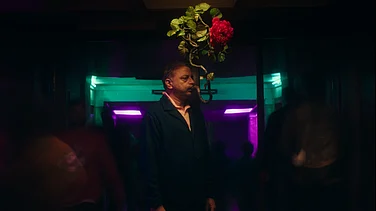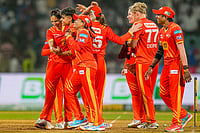
Rajesh Khanna's role in Aradhna catapulated him to superstar status
Though Khanna had made his debut in Chetan Anand's offbeat Aakhri Khat (1966) after winning a talent contest and won favourable notices for films such as Khamoshi, Doli and Bandhan, it was Mere sapnon ki rani and Aradhana that catapulted him to superstardom. The rise and rise of the 'phenomenon'—as veteran film journalist Devyani Chaubal dubbed him—is well documented, but worth recounting for a land where half the population was not even born during the Khanna era. A nation, then, was in thrall, not only to his innumerable hit films, where he became synonymous with romance, but also to his colourful private life. The country eagerly lapped up gossip morsels about his stormy relationship with Anju Mahendru, swooned over his guru-kurta and sighed over his fairytale romance and marriage with the young Dimple Kapadia. Only Hrithik Roshan, for a brief spell post the Kaho Naa Pyar Hai release, has tasted that intensity of adulation in recent times.
Superstardom can be accompanied by hubris and Khanna succumbed, famously saying that the constant idolisation made him feel 'next to God'. Downfall was imminent and the rise of a certain Amitabh Bachchan, coupled with the Hindi film industry's tectonic shift from romantic dramas towards more violent fare, exacerbated the process. Bachchan, who played an ideal foil to Khanna in Anand (1971), turned in a showboating performance that rivalled the superstars in Namak Haraam (1973). The Superstar is dead. Long live the Superstar! to paraphrase Le Roi est mort. Vive le Roi!
The fall was gradual rather than swift. There were indeed worthy films in the early '80s like Thodisi Bewafaii, Dard, Kudrat, Avtaar and Souten offering a glimpse of what once was. But the turkey count mounted apace with the erstwhile superstar appearing in gems like Ashanti, Rajput and even trying desperately to gatecrash Jeetendra's Padmalaya honeymoon in the dire Maqsad. Like his successor Bachchan, politics inevitably followed, with Khanna serving as a New Delhi MP 1991-96.
Ironically, the latest star saluted with the superstar honorific, after a stellar box-office run over the last few years, is Khanna's son-in-law Akshay, who's married to Twinkle Khanna. Like his father-in-law, he changed his name—from Rajiv Hari Om Bhatia. India's young population is well aware of his gradual rise through the ranks after stints as a chef in Bangkok, martial arts instructor and the numerous successful Khiladi films. Hera Pheri marked his transition from an action hero to a comic one and Ek Rishtaa began the showcasing of his dramatic chops. The year 2007 was Akshay's watershed as success followed humongous success, with Namastey London, Heyy Babyy, Bhool Bhulaiyya and Welcome. Akshay finally took his rightful place alongside the Khan triumvirate after a decade where they dominated.
Today, Akshay is almost as ubiquitous as Shahrukh Khan. He's in the news for demanding and receiving unbelievable amounts of money for his forthcoming films such as Warner Bros' Chandni Chowk to China; being Delhi's Daredevil at their inaugural IPL match; hospitalised for the sake of a popular cola in a TV commercial; and deigning to appear alongside the Bachchans at select venues on the upcoming Unforgettable concert tour. As he basks in his hard-earned success, Akshay could do well to look back at the decline and fall of his once-illustrious father-in-law. In the immortal words of Marcus Aurelius, "All is ephemeral—fame and the famous as well". After a lull, Khanna's contemporary Bachchan managed his renaissance spectacularly. Though Khanna has reportedly signed eight films on a comeback trail, his last few years have been dismal. Roles in television serials like Apne Paraye and Ittefaq and the abysmal Jaana: Let's Fall in Love alongside Zeenat Aman scarcely does justice to his undeniable talent.
The television programme K For Kishore recently had a two-day celebration of Khanna. What Akshay can't take away from Khanna is that in spite of his decline, Khanna has created a lasting body of work—films and songs that are heralded as classics in the annals of Hindi cinema. For all his success, Akshay has produced nothing that matches an Amar Prem or an Avishkaar. To be fair, it can be argued that today's 'consume today forget tomorrow' film culture reflects that hoary old chestnut—Bollywood's creative bankruptcy. Still, given his pre-eminent status, Akshay could greenlight projects that will stand the test of time. Somehow, Zindagi kaisi hai paheli haaye, kabhi yeh hasaaye, kabhi yeh rulaaye—poignantly evocative of Khanna's own life—has more lasting resonance than, say, a Churake dil mera.
Late April 2008. Akshay's latest project Kambakkht Ishq goes into pre-production. It's going to be the first Bollywood film to be shot at Hollywood's Universal Studios. Curiously enough, Akshay plays a stuntman. Nary a mention in the credits of the Producer Who Shall Not Be Named, whose dream project this was supposed to be.
As T.S. Eliot said in The Waste Land, while quoting the Brihadaranyaka Upanishad: "Shantih, Shantih, Shantih."
(Naman Ramachandran is the author of Lights Camera Masala: Making Movies in Mumbai.)





















